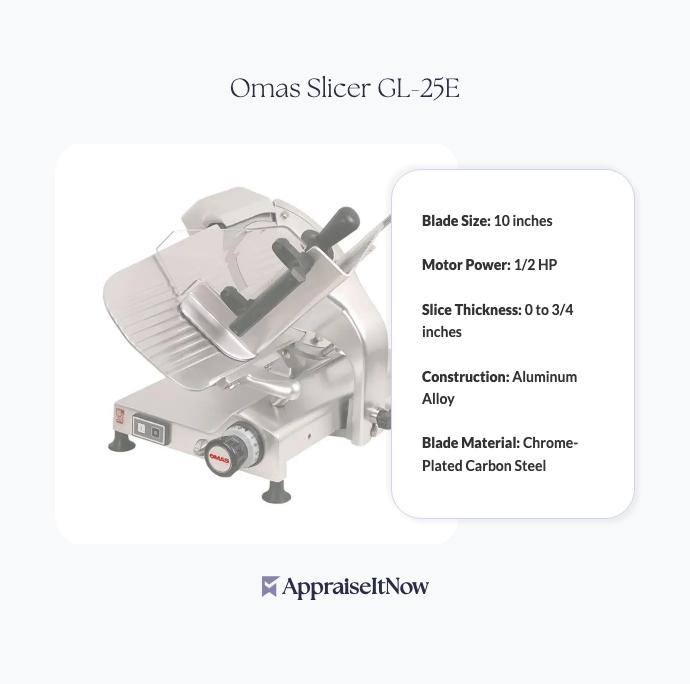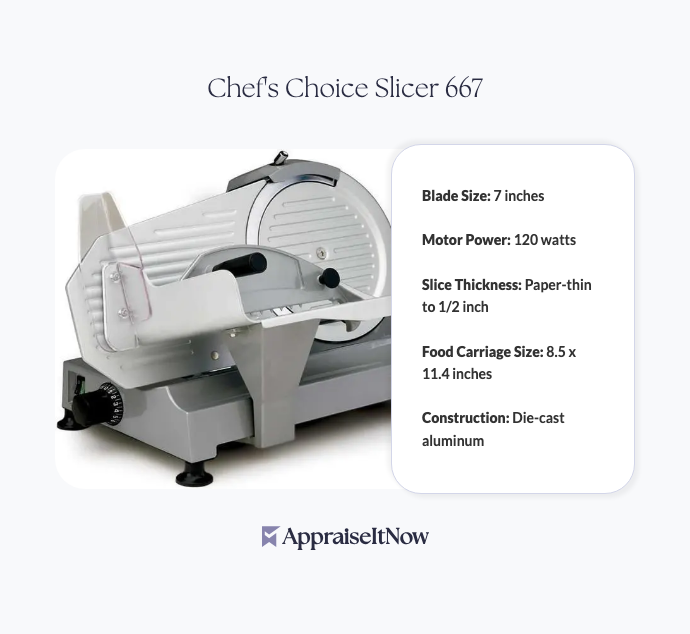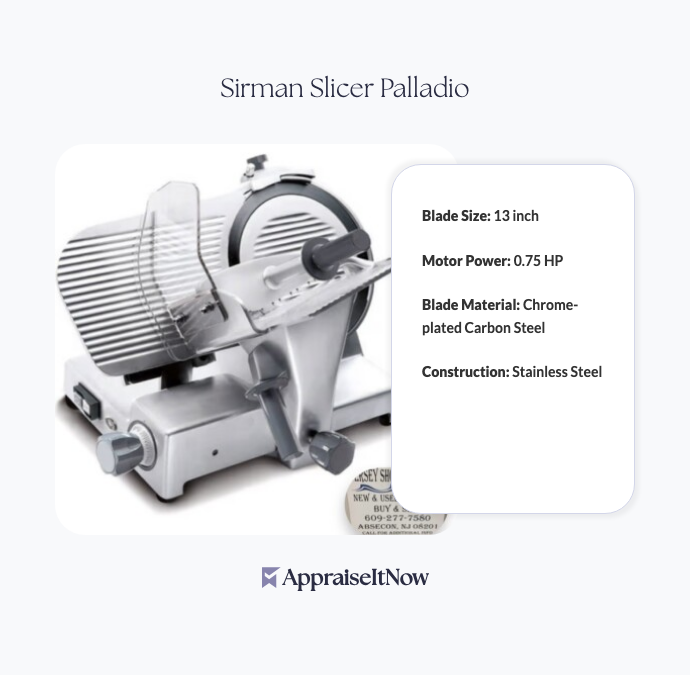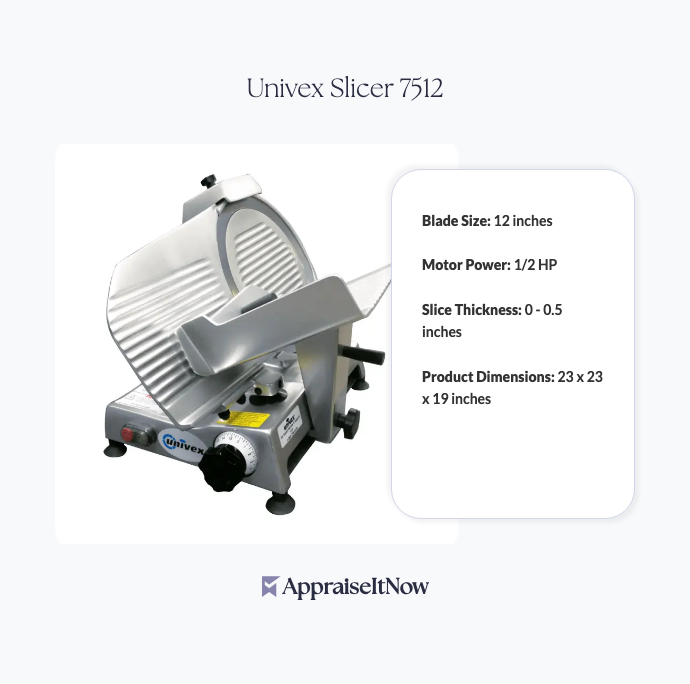<h1>How to Get Your Urschel Slicer Model 2A Appraised</h1>
<p>The <strong>Urschel Slicer Model 2A</strong> represents a significant investment in commercial food processing equipment, commanding estimated values between <strong>$16,000 and $20,000</strong> in today's market. Whether you're considering selling, purchasing, or need documentation for insurance or collateral purposes, understanding how to approach the appraisal process ensures you receive an accurate valuation that reflects your equipment's true worth.</p>
<h2>Understanding Your Urschel Model 2A's Market Position</h2>
<p>Since its introduction in <strong>1960</strong>, the Urschel Slicer Model 2A has become a staple in professional kitchens and food processing facilities worldwide. This industrial-grade equipment features a powerful 3 HP motor, precision slicing capabilities ranging from 1/32 to 1/2 inch, and durable stainless steel construction that allows it to handle everything from firm vegetables to delicate meats with consistent, reliable performance.</p>
<p>The Model 2A's reputation for durability and precision slicing has made it highly sought-after in the commercial food service equipment market. Unlike equipment with mechanical limitations or reliability concerns, the Urschel's proven track record across decades of use means well-maintained units retain substantial residual value. When evaluating comparable <a href="/types/food-processing-equipment">food processing equipment</a>, the Model 2A consistently ranks among the most desirable pre-owned units available.</p>
<div class="callout tip"><p><strong>Market Insight</strong></p>
<p>Current market demand for used food processing equipment has remained steady, with commercial kitchen retrofits and equipment upgrades driving consistent buyer interest in quality pre-owned slicers.</p></div>
<h2>Key Factors That Influence Your Urschel Model 2A's Appraisal Value</h2>
<p>Several interconnected factors determine where your specific unit falls within the <strong>$16,000–$20,000</strong> valuation range. Age, condition, configuration, and available accessories each play distinct roles in establishing fair market value, and understanding these elements helps you prepare comprehensive documentation for appraisal purposes.</p>
<h3>Age and Manufacturing Date</h3>
<p>Your equipment's serial number and manufacturing date provide critical baseline information for appraisers. An original <strong>1960s or 1970s Model 2A</strong> with documented provenance commands premium pricing compared to units manufactured in the 1980s or later, reflecting both scarcity and the cultural value collectors place on equipment from the slicer's foundational production era. The serial number not only establishes authenticity but also helps verify original specifications and potential factory modifications.</p>
<h3>Condition and Mechanical Performance</h3>
<p>Professional appraisers assess condition across multiple dimensions that directly impact value. Blade sharpness and alignment, motor performance, electrical system integrity, and the functionality of all precision mechanisms all factor into condition grading. Surface corrosion on the stainless steel housing, worn gaskets, or mechanical slop in the feed mechanism can reduce valuation by 15–30% depending on severity. Equipment that starts reliably, maintains consistent slice thickness, and requires only routine maintenance commands the premium end of the valuation spectrum.</p>
<h3>Original Components and Modifications</h3>
<p>Your Urschel Model 2A's value decreases when non-original parts have been substituted or significant modifications made to the original design. Replacement motors, aftermarket slicing discs, or custom feed mechanisms may improve functionality but reduce collector and commercial buyer interest. Conversely, equipment with matching original parts, factory accessories, and unmodified specifications achieves higher appraisal values. Documentation showing when original components were installed and what replacements were made becomes essential for transparent valuation.</p>
<div class="callout note"><p><strong>Appraisal Consideration</strong></p>
<p>Modifications or non-original parts directly impact both appraisal value and marketability, potentially reducing value by 10–25% depending on the nature and extent of changes.</p></div>
<h2>Documentation That Strengthens Your Appraisal</h2>
<p>Effective appraisals depend on comprehensive supporting documentation that establishes your equipment's history, maintenance, and current condition. The stronger your documentation package, the more confidently appraisers can justify valuations and the more quickly you can complete buying or selling transactions.</p>
<h3>Essential Records to Compile</h3>
<p>Begin by gathering your <strong>original purchase invoice</strong> if available, as it establishes authenticity, original price point, and factory specifications. Service and maintenance logs prove you've invested in proper care and provide evidence of mechanical reliability. Records of parts replaced—including dates, costs, and work descriptions—demonstrate responsible stewardship and help appraisers assess remaining useful life.</p>
<p>Photographs from multiple angles, particularly close-ups showing condition of the slicing mechanism, motor housing, and electrical components, give appraisers visual reference for remote assessments or preliminary valuations. For equipment still in operation, videos demonstrating startup, slicing performance across different thickness settings, and clean shutdown provide compelling documentation of functionality.</p>
<h3>Provenance and Chain of Custody</h3>
<p>If you purchased the equipment from a previous owner, gather any sales records, correspondence, or business documentation that establishes the equipment's history. Food service businesses sometimes maintain detailed equipment logs; these records substantially strengthen appraisal documentation. For equipment acquired through auctions or liquidations, preserve whatever paperwork accompanied the purchase.</p>
<h2>Regional Factors and Transportation Costs</h2>
<p>Your geographic location and the buyer's location influence net realizable value in ways that affect appraisal positioning. Equipment located in major metropolitan areas with dense commercial kitchen populations typically commands premium pricing compared to rural settings where buyer pools are smaller. Transportation logistics also factor into valuation—large, heavy equipment like the Model 2A involves significant shipping costs, which sophisticated buyers account for when making purchase decisions.</p>
<p>Professional appraisers familiar with regional <a href="/types/equipment-and-machinery">equipment and machinery markets</a> understand these geographic variations and often provide location-adjusted valuations that reflect realistic selling prices in your specific market. When seeking appraisals, specify your location and any known buyer interest to ensure valuations reflect your actual market conditions.</p>
<h2>Compliance, Safety, and Food-Grade Considerations</h2>
<p>Modern food service operations face increasingly stringent sanitation and safety regulations. Your Model 2A's ability to meet current food-grade standards, sanitation requirements, and safety compliance directly impacts its commercial viability and appraisal value. Equipment with removable parts that facilitate thorough cleaning, stainless steel construction resistant to food contamination, and proper electrical grounding systems commands stronger appraisals than models requiring significant upgrades to meet contemporary standards.</p>
<p>If your slicer requires safety modifications or sanitation upgrades to meet current regulations, appraisers typically account for these costs in their valuations. Well-maintained equipment already compliant with food service standards receives full valuation credit, while units requiring significant remediation see corresponding reductions.</p>
<h2>Appraisal Methods for Commercial Equipment</h2>
<p>Professional appraisers typically employ one of three depreciation methods when valuing commercial food processing equipment, and understanding these approaches helps you anticipate appraisal conclusions. The <strong>straight-line depreciation method</strong> assumes equal annual value loss; the <strong>declining balance method</strong> applies higher depreciation in early years; and the <strong>sum-of-years-digits method</strong> combines elements of both approaches. For a Model 2A manufactured in 1960 and appraised today, the resulting valuations typically converge around the <strong>$16,000–$20,000</strong> range, though specific method selection can create variations of 5–15%.</p>
<p>Appraisers also employ <strong>comparative market analysis</strong>, examining recent transactions for comparable Urschel Model 2A slicers to establish fair market benchmarks. This approach provides the most transparent and defensible valuations, particularly when multiple documented sales have occurred within the previous 12–24 months.</p>
<h2>When to Seek Professional Appraisal</h2>
<p>Understanding when a formal appraisal becomes essential helps you make cost-effective decisions about professional valuation services. Equipment valued at <strong>$16,000–$20,000</strong> typically warrants professional appraisal in several specific situations: when preparing for sale through commercial equipment brokers or auctions, when documenting assets for insurance purposes, when establishing collateral value for business financing, or when settling business disputes or estate matters requiring independent valuation.</p>
<p>Appraisal costs typically range from <strong>$300–$800</strong> depending on the appraiser's travel distance and assessment complexity. For equipment valued at $16,000–$20,000, professional appraisal fees represent 1.5–5% of asset value—a reasonable investment for documentation that protects your interests in significant transactions. When appraisal costs represent expected recovery values, the analysis becomes straightforward: formal appraisal makes financial sense and should be pursued.</p>
<p>Our comprehensive guides on <a href="/blog/understand-the-value-of-your-equipment-and-machinery-with-an-appraisal">understanding equipment and machinery appraisals</a> and <a href="/blog/common-mistakes-to-avoid-when-getting-an-equipment-and-machinery-appraisal">avoiding common appraisal mistakes</a> provide additional context for navigating the professional valuation process.</p>
<div class="callout tip"><p><strong>Pro Tip</strong></p>
<p>When seeking appraisal quotes, provide detailed information about your equipment's condition, manufacturing date, and intended use (sale, insurance, collateral). This enables appraisers to provide more accurate preliminary estimates before site visits.</p></div>
<h2>Connecting with Qualified Appraisers</h2>
<p><strong>AppraiseItNow</strong> connects equipment owners with credentialed appraisers specializing in commercial food processing equipment. Our network includes professionals with <strong>AAA, ISA, ASA, CAGA, and AMEA</strong> certifications—credentials that ensure USPAP-compliant valuations accepted by insurance companies, financial institutions, and courts. The appraisal platform enables you to upload equipment photographs, detailed descriptions, and supporting documentation securely, facilitating rapid preliminary assessments and accurate final valuations.</p>
<p>Whether you're evaluating a single piece of equipment or managing comprehensive asset documentation for your business, professional appraisal services provide the expertise and credibility necessary to support your financial and operational decisions. For more detailed information on <a href="/blog/what-to-consider-when-choosing-an-appraisal-company-for-equipment-and-machinery-valuation">selecting qualified appraisal providers</a>, consult our resources on identifying appraiser qualifications and verifying credentials.</p>
<hr />
<div class="callout note"><p><strong>Key Takeaway</strong></p>
<p>Your Urschel Slicer Model 2A's estimated value of $16,000–$20,000 makes professional appraisal a worthwhile investment for sale, insurance, or collateral documentation. By gathering comprehensive records, understanding the factors influencing commercial equipment values, and working with credentialed appraisers, you ensure accurate valuation and confident decision-making in significant equipment transactions.</p></div>
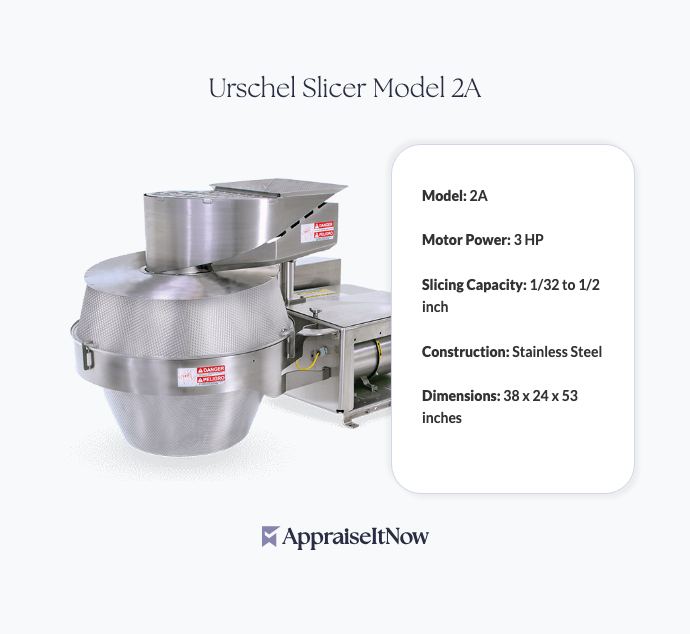






.avif)




